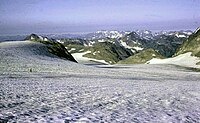
Photo from wikipedia
A major ice collapse ( ≈ 10,000 m3 ) from a hanging glacier on Mount Eiger, Switzerland was recorded by a small aperture array as a broadband (0.1–10 Hz) infrasound… Click to show full abstract
A major ice collapse ( ≈ 10,000 m3 ) from a hanging glacier on Mount Eiger, Switzerland was recorded by a small aperture array as a broadband (0.1–10 Hz) infrasound signal. Array analysis reveals that the high ( ≈ 3 Hz) frequency signal is infrasound produced by the moving ice mass, and its back azimuth variation with time tracks the ice mass trajectory and provides a mean velocity estimate. Infrasound frequency is used to estimate a radius, that despite overestimating the volume, provides quantitative analysis in near‐real time. The low ( ≈ 0.1 Hz) frequency oscillation is modeled in terms of the velocity field (wind), which the moving ice mass induces on the surrounding air, producing pressure variations at the different elements. These results show how infrasound array observations may provide quantitative information of glacier collapse and ice avalanche trajectories, and possibly, volume.
Journal Title: Geophysical Research Letters
Year Published: 2021
Link to full text (if available)
Share on Social Media: Sign Up to like & get
recommendations!